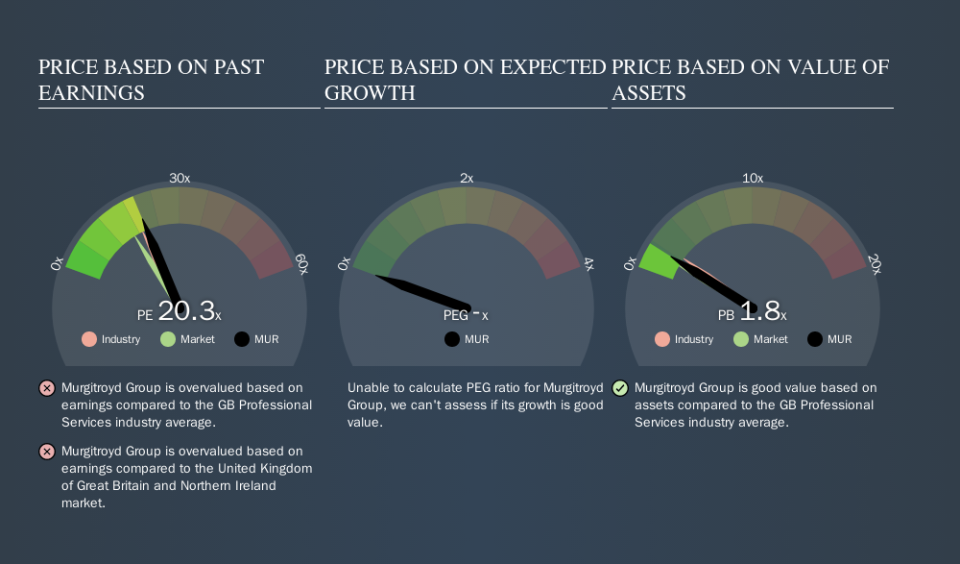How Does Murgitroyd Group's (LON:MUR) P/E Compare To Its Industry, After Its Big Share Price Gain?

Murgitroyd Group (LON:MUR) shares have had a really impressive month, gaining 36%, after some slippage. However, the annual gain of 6.3% wasn't so impressive.
Assuming no other changes, a sharply higher share price makes a stock less attractive to potential buyers. While the market sentiment towards a stock is very changeable, in the long run, the share price will tend to move in the same direction as earnings per share. The implication here is that deep value investors might steer clear when expectations of a company are too high. One way to gauge market expectations of a stock is to look at its Price to Earnings Ratio (PE Ratio). Investors have optimistic expectations of companies with higher P/E ratios, compared to companies with lower P/E ratios.
View our latest analysis for Murgitroyd Group
How Does Murgitroyd Group's P/E Ratio Compare To Its Peers?
Murgitroyd Group has a P/E ratio of 20.34. The image below shows that Murgitroyd Group has a P/E ratio that is roughly in line with the professional services industry average (20.3).
That indicates that the market expects Murgitroyd Group will perform roughly in line with other companies in its industry. So if Murgitroyd Group actually outperforms its peers going forward, that should be a positive for the share price. I would further inform my view by checking insider buying and selling., among other things.
How Growth Rates Impact P/E Ratios
If earnings fall then in the future the 'E' will be lower. That means unless the share price falls, the P/E will increase in a few years. Then, a higher P/E might scare off shareholders, pushing the share price down.
It's great to see that Murgitroyd Group grew EPS by 12% in the last year. Unfortunately, earnings per share are down 2.1% a year, over 3 years.
Don't Forget: The P/E Does Not Account For Debt or Bank Deposits
Don't forget that the P/E ratio considers market capitalization. So it won't reflect the advantage of cash, or disadvantage of debt. Theoretically, a business can improve its earnings (and produce a lower P/E in the future) by investing in growth. That means taking on debt (or spending its cash).
Such expenditure might be good or bad, in the long term, but the point here is that the balance sheet is not reflected by this ratio.
How Does Murgitroyd Group's Debt Impact Its P/E Ratio?
Murgitroyd Group's net debt is 3.5% of its market cap. It would probably trade on a higher P/E ratio if it had a lot of cash, but I doubt it is having a big impact.
The Verdict On Murgitroyd Group's P/E Ratio
Murgitroyd Group's P/E is 20.3 which is above average (16.4) in its market. Its debt levels do not imperil its balance sheet and it is growing EPS strongly. So on this analysis it seems reasonable that its P/E ratio is above average. What is very clear is that the market has become significantly more optimistic about Murgitroyd Group over the last month, with the P/E ratio rising from 14.9 back then to 20.3 today. For those who prefer to invest with the flow of momentum, that might mean it's time to put the stock on a watchlist, or research it. But the contrarian may see it as a missed opportunity.
When the market is wrong about a stock, it gives savvy investors an opportunity. People often underestimate remarkable growth -- so investors can make money when fast growth is not fully appreciated. So this free report on the analyst consensus forecasts could help you make a master move on this stock.
Of course you might be able to find a better stock than Murgitroyd Group. So you may wish to see this free collection of other companies that have grown earnings strongly.
We aim to bring you long-term focused research analysis driven by fundamental data. Note that our analysis may not factor in the latest price-sensitive company announcements or qualitative material.
If you spot an error that warrants correction, please contact the editor at editorial-team@simplywallst.com. This article by Simply Wall St is general in nature. It does not constitute a recommendation to buy or sell any stock, and does not take account of your objectives, or your financial situation. Simply Wall St has no position in the stocks mentioned. Thank you for reading.


